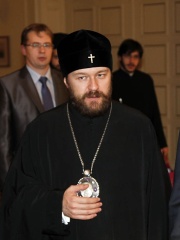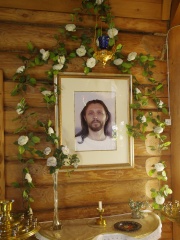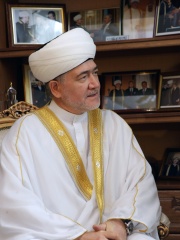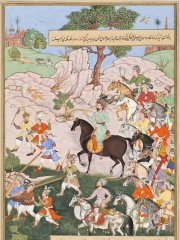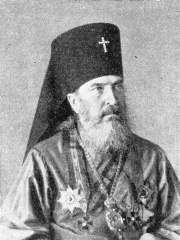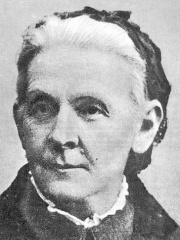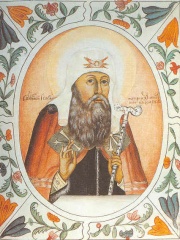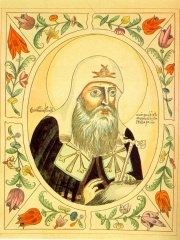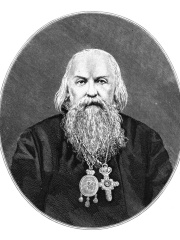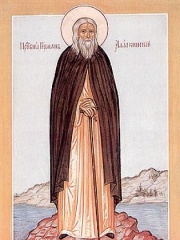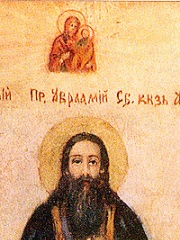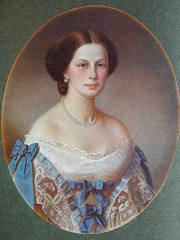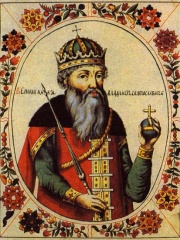
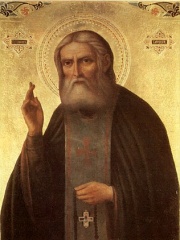
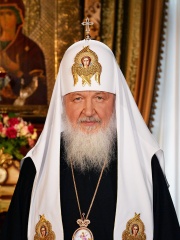
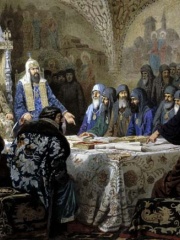
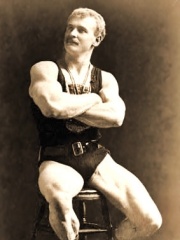
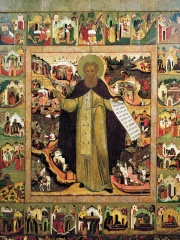
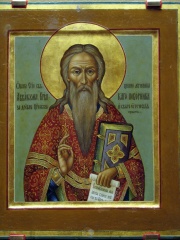
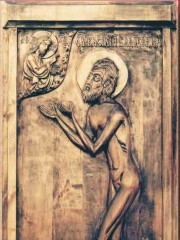
The Most Famous
RELIGIOUS FIGURES from Russia
This page contains a list of the greatest Russian Religious Figures. The pantheon dataset contains 2,238 Religious Figures, 39 of which were born in Russia. This makes Russia the birth place of the 14th most number of Religious Figures behind Poland and Greece.
Top 10
The following people are considered by Pantheon to be the top 10 most legendary Russian Religious Figures of all time. This list of famous Russian Religious Figures is sorted by HPI (Historical Popularity Index), a metric that aggregates information on a biography’s online popularity. Visit the rankings page to view the entire list of Russian Religious Figures.

1. Vladimir the Great (958 - 1015)
With an HPI of 74.58, Vladimir the Great is the most famous Russian Religious Figure. His biography has been translated into 62 different languages on wikipedia.
Vladimir I Sviatoslavich or Volodymyr I Sviatoslavych (Old East Slavic: Володимѣръ Свѧтославичь, romanized: Volodiměr Svętoslavič; Christian name: Basil; c. 958 – 15 July 1015), given the epithet "the Great", was Prince of Novgorod from 970 and Grand Prince of Kiev from 978 until his death in 1015. The Eastern Orthodox Church canonised him as Saint Vladimir. Vladimir's father was Sviatoslav I of the Rurik dynasty. After the death of his father in 972, Vladimir, who was then the prince of Novgorod, was forced to flee abroad after his brother Yaropolk murdered his other brother Oleg in 977 to become the sole ruler of Rus'. Vladimir assembled a Varangian army and returned to depose Yaropolk in 978. By 980, Vladimir had consolidated his realm to the Baltic Sea and solidified the frontiers against incursions of Bulgarians, Baltic tribes and Eastern nomads. Originally a follower of Slavic paganism, Vladimir converted to Christianity in 988, and Christianized the Kievan Rus.

2. Seraphim of Sarov (1754 - 1833)
With an HPI of 65.91, Seraphim of Sarov is the 2nd most famous Russian Religious Figure. His biography has been translated into 36 different languages.
Seraphim of Sarov (Russian: Серафим Саровский; 30 July [O.S. 19 July] 1754 (or 1759) – 14 January [O.S. 2 January] 1833), born Prókhor Isídorovich Moshnín (Mashnín) [Про́хор Иси́дорович Мошни́н (Машни́н)], is one of the most renowned Russian saints and is venerated in the Eastern Orthodox Church and the Anglican Communion. He is generally considered the greatest of the 18th-century startsy (elders). Seraphim extended the monastic teachings of contemplation, theoria and self-denial to the layperson. He taught that the purpose of the Christian life was to receive the Holy Spirit. Perhaps his most popular quotation amongst his devotees is "acquire a peaceful spirit, and thousands around you will be saved." Seraphim was glorified by the Russian Orthodox Church in 1903.

3. Patriarch Kirill of Moscow (1946 - )
With an HPI of 64.60, Patriarch Kirill of Moscow is the 3rd most famous Russian Religious Figure. His biography has been translated into 56 different languages.
Kirill or Cyril (Russian: Кирилл, Church Slavonic: Ст҃ѣ́йшїй патрїа́рхъ кѷрі́ллъ, secular name Vladimir Mikhailovich Gundyayev, Russian: Владимир Михайлович Гундяев; born 20 November 1946) is a Russian Orthodox bishop. He became Patriarch of Moscow and all Rus' and Primate of the Russian Orthodox Church on 1 February 2009. Prior to becoming Patriarch, Kirill was Archbishop (later Metropolitan) of Smolensk and Kaliningrad, and also Chairman of the Russian Orthodox Church's Department for External Church Relations. He has been a permanent member of the Holy Synod since 1989. A close ally of Russian leader Vladimir Putin, Kirill has described Putin's rule as "a miracle of God". According to Putin, Kirill's father baptized him. During his tenure as Patriarch of Moscow and all Rus', Kirill has brought the Russian Orthodox Church closer to the Russian state. Kirill's relationship with Bartholomew I of Constantinople, Ecumenical Patriarch and the spiritual leader of Eastern Orthodox Christians worldwide, has been tense. After Kirill lauded the Russian invasion of Ukraine, clergy in other Orthodox Churches condemned his remarks, with Bartholomew I saying that Kirill's support for Putin and the war were "damaging to the prestige of the whole of Orthodoxy".

4. Patriarch Nikon of Moscow (1605 - 1681)
With an HPI of 62.17, Patriarch Nikon of Moscow is the 4th most famous Russian Religious Figure. His biography has been translated into 47 different languages.
Nikon (Russian: Ни́кон, Old Russian: Нїконъ), born Nikita Minin (Никита Минин; 7 May 1605 – 17 August 1681) was the seventh Patriarch of Moscow and all Rus' of the Russian Orthodox Church, serving officially from 1652 to 1666. He was renowned for his eloquence, energy, piety and close ties to Tsar Alexis of Russia. Nikon introduced many reforms, including liturgical reforms that were unpopular among conservatives. These divisions eventually led to a lasting schism known as Raskol (schism) in the Russian Orthodox Church. For many years, he was a dominant political figure, often equaling or even overshadowing the Tsar. In December 1667, Nikon was tried by a synod of church officials, deprived of all his sacerdotal functions, and reduced to the status of a simple monk.
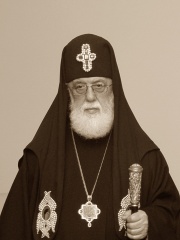
5. Ilia II of Georgia (1933 - )
With an HPI of 61.88, Ilia II of Georgia is the 5th most famous Russian Religious Figure. His biography has been translated into 49 different languages.
Ilia II (Georgian: ილია II, romanized: ilia II; born 4 January 1933), also transcribed as Ilya or Elijah, is the Catholicos-Patriarch of All Georgia, the spiritual leader of the Georgian Orthodox Church. He is officially styled as "Catholicos-Patriarch of All Georgia, the Archbishop of Mtskheta-Tbilisi and Metropolitan Bishop of Bichvinta and Tskhum-Abkhazia, His Holiness and Beatitude Ilia II."

6. Eugen Sandow (1867 - 1925)
With an HPI of 61.44, Eugen Sandow is the 6th most famous Russian Religious Figure. His biography has been translated into 28 different languages.
Eugen Sandow (born Friedrich Wilhelm Müller, German: [ˈfʁiːdʁɪç ˈvɪlhɛlm ˈmʏlɐ]; 2 April 1867 – 14 October 1925) was a German bodybuilder and showman from Prussia. Born in Königsberg, Sandow became interested in bodybuilding at the age of ten during a visit to Italy. After a spell in the circus, Sandow studied under strongman Ludwig Durlacher in the late 1880s. On Durlacher's recommendation, he began entering strongman competitions, performing in matches against leading figures in the sport such as Charles Sampson, Frank Bienkowski, and Henry McCann. In 1901 he organised what is believed to be the world's first major bodybuilding competition. Set in London's Royal Albert Hall, Sandow judged the event alongside author Sir Arthur Conan Doyle and athlete/sculptor Charles Lawes-Wittewronge.

7. Sergius of Radonezh (1314 - 1392)
With an HPI of 60.19, Sergius of Radonezh is the 7th most famous Russian Religious Figure. His biography has been translated into 32 different languages.
Sergius of Radonezh (Russian: Сергий Радонежский, romanized: Sergiy Radonezhsky; 14 May 1314 – 25 September 1392) was a spiritual leader and monastic reformer of medieval Russia. Together with Seraphim of Sarov, he is one of Eastern Orthodoxy's most highly venerated saints in Russia.

8. Avvakum (1620 - 1682)
With an HPI of 60.17, Avvakum is the 8th most famous Russian Religious Figure. His biography has been translated into 37 different languages.
Avvakum Petrov (Russian: Аввакум Петров; 20 November 1620/21 – 14 April 1682; also spelled Awakum) was a Russian Old Believer and protopope of the Kazan Cathedral on Red Square who led the opposition to Patriarch Nikon's reforms of the Russian Orthodox Church. His autobiography and letters to the tsar and other Old Believers such as Boyarynya Morozova are considered masterpieces of 17th-century Russian literature.

9. Basil Fool for Christ (1468 - 1552)
With an HPI of 60.15, Basil Fool for Christ is the 9th most famous Russian Religious Figure. His biography has been translated into 25 different languages.
Vasily the Blessed (known also as Basil, and as the fool for Christ; the Wonderworker of Moscow; or Blessed Vasily of Moscow; Russian: Василий Блаженный, Vasily Blazhenny) is a Russian Orthodox saint of the type known as yurodivy or "holy fool".
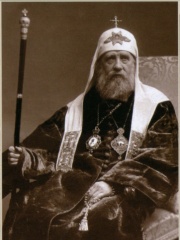
10. Patriarch Tikhon of Moscow (1865 - 1925)
With an HPI of 57.98, Patriarch Tikhon of Moscow is the 10th most famous Russian Religious Figure. His biography has been translated into 31 different languages.
Tikhon of Moscow (Russian: Тихон Московский, 31 January [O.S. 19 January] 1865 – 7 April [O.S. 25 March] 1925), born Vasily Ivanovich Bellavin (Russian: Василий Иванович Беллавин), was a bishop of the Russian Orthodox Church (ROC). On 5 November 1917 (OS) he was selected the 11th Patriarch of Moscow and All Russia, after a period of about 200 years of the Synodal rule in the ROC. He was canonised as a confessor by the ROC in 1989.
Pantheon has 39 people classified as religious figures born between 958 and 1966. Of these 39, 6 (15.38%) of them are still alive today. The most famous living religious figures include Patriarch Kirill of Moscow, Ilia II of Georgia, and Grigory Rodchenkov. The most famous deceased religious figures include Vladimir the Great, Seraphim of Sarov, and Patriarch Nikon of Moscow. As of April 2022, 9 new religious figures have been added to Pantheon including Patriarch Job of Moscow, Patriarch Hermogenes of Moscow, and Gamzat-bek.
Living Religious Figures
Go to all Rankings
Patriarch Kirill of Moscow
1946 - Present
HPI: 64.60
Ilia II of Georgia
1933 - Present
HPI: 61.88
Grigory Rodchenkov
1958 - Present
HPI: 46.25
Hilarion
1966 - Present
HPI: 42.76
Vissarion
1961 - Present
HPI: 42.07
Rawil Gaynetdin
1959 - Present
HPI: 39.97

Deceased Religious Figures
Go to all Rankings
Vladimir the Great
958 - 1015
HPI: 74.58
Seraphim of Sarov
1754 - 1833
HPI: 65.91
Patriarch Nikon of Moscow
1605 - 1681
HPI: 62.17
Eugen Sandow
1867 - 1925
HPI: 61.44
Sergius of Radonezh
1314 - 1392
HPI: 60.19
Avvakum
1620 - 1682
HPI: 60.17
Basil Fool for Christ
1468 - 1552
HPI: 60.15
Patriarch Tikhon of Moscow
1865 - 1925
HPI: 57.98
Tode Mongke
1282 - 1287
HPI: 57.54
Nicholas of Japan
1836 - 1912
HPI: 57.19
Maria Alexandrovna Ulyanova
1835 - 1916
HPI: 57.09
Xenia of Saint Petersburg
1719 - 1803
HPI: 56.86

Newly Added Religious Figures (2022)
Go to all Rankings
Patriarch Job of Moscow
1525 - 1607
HPI: 51.68
Patriarch Hermogenes of Moscow
1530 - 1612
HPI: 51.02
Gamzat-bek
1789 - 1834
HPI: 51.01
Ignatius Brianchaninov
1807 - 1867
HPI: 49.67
Herman of Alaska
1756 - 1837
HPI: 48.12
Abraham of Smolensk
1172 - 1221
HPI: 47.94
Anna Filosofova
1837 - 1912
HPI: 47.42
Grigory Rodchenkov
1958 - Present
HPI: 46.25
Rawil Gaynetdin
1959 - Present
HPI: 39.97

Which Religious Figures were alive at the same time? This visualization shows the lifespans of the 20 most globally memorable Religious Figures since 1700.


